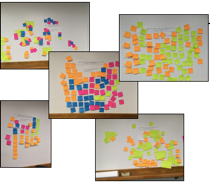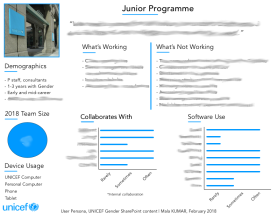Since December 2017, I have worked with the UNICEF Gender team as a SharePoint designer. In this role, I am creating a new content repository, including its information architecture, taxonomy/tags, flows (points of automation), and user permissions. I’m also in charge of leading the redesign of the front-end of the SharePoint Gender website, as UNICEF is making a transition to SharePoint Modern in late August.
Gender is a unique section at UNICEF HQ due to the wide thematic range it covers. I therefore knew there would be differences among the different workstreams within the section. Thus, one of the first research steps I took was conduct in-depth interviews with half of the team.

With many mutually exclusive thematic areas to cover, I conducted an in-person activity with nearly every member of the team. In the activity, I asked each section team member to write down the answers to three questions on individual post-it notes:
- What words come to mind when I say Gender content?
- What types of documents do you work with? Budgets? Annual Reports?
- How might you group documents? By theme? By time? By role?
I then asked the section team members to group their responses and discuss the patterns that emerged. The activity led to a great discussion and a solid foundation by which to create the first draft of the information architecture and taxonomy.
Information Architecture
The information architecture (IA) or, in this case, the folder structure, was the most complicated aspect to determine. Following the in-person activity in January, I asked the Gender team to fill out an online survey to solicit comments on the folders that had emerged.
The survey contained questions with pre-determined responses. If a majority of the team indicated a folder did not make sense, I threw out the folder. On the open-ended questions, some team members had great suggestions to alternate structures and names. Other feedback was vague. I incorporated concrete, logical feedback into the next draft IA.
I interpreted less consensus on where to place files as an indication something needed to change or at least be flagged ahead of file sorting. In the top level of the IA, changes could not be made because those folders correspond to funding streams. Lower levels of the IA were changeable.
Other Major Research Deliverables
- Taxonomy – as data with a hierarchy, the taxonomy proved confusing. However, when I took out any indication of hierarchy, the same words proved easy to understand. Thus, the tags are presented as categories and corresponding words. I provided the tags as both a spreadsheet and a searchable list online through Optimal Workshop.
- User Permissions – determining user permissions was a fairly straightforward exercise, as most team members are grouped in distinct workstreams and most Gender work is shared freely within the team.
- Naming Convention – per the recommendations of UNICEF IT, I created a modified file naming convention that would both suit the old version of SharePoint and the new SharePoint Modern that will be rolled out in August 2018.
- Flows – Among the insights that fleshed out from my work was points of automation in the Gender team’s workflows. I recorded these down as steps in a flow, which may eventually be implemented through a Logic App or Microsoft Flows.
Migration Options
One decision the senior team had to make was which files to migrate to the new content repository. After speaking with most of the team, I presented three options: migrate everything, migrate final/latest versions, migrate only documents shareable outside of UNICEF Gender.
Migration Process Workflow
Using the research, I created the final information architecture and taxonomy. I then created and implemented a migration process workflow that I used to populate the content repository. As of November 2018, there are 1200+ files contributed from 15 team members, putting the team ahead of nearly all others in the organization.






